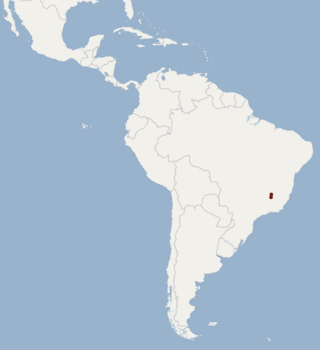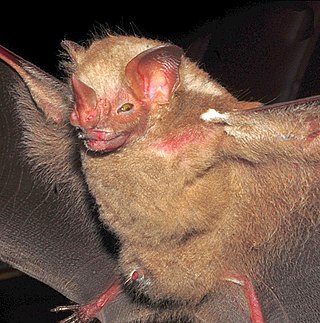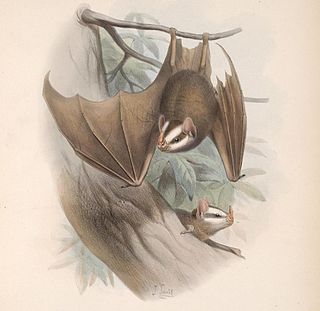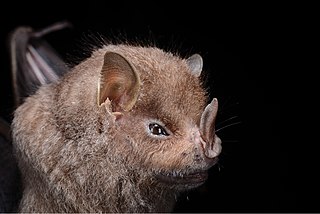
The New World leaf-nosed bats (Phyllostomidae) are bats found from southern North America to South America, specifically from the Southwest United States to northern Argentina. They are ecologically the most varied and diverse family within the order Chiroptera. Most species are insectivorous, but the phyllostomid bats include within their number true predatory species and frugivores. For example, the spectral bat, the largest bat in the Americas, eats vertebrate prey, including small, dove-sized birds. Members of this family have evolved to use food groups such as fruit, nectar, pollen, insects, frogs, other bats, and small vertebrates, and in the case of the vampire bats, even blood.

Desmodus is a genus of bats which—along with the genera Diaemus and Diphylla—are allied as the subfamily Desmodontinae, the carnivorous, blood-consuming vampire bats of the New World leaf-nosed bat family Phyllostomidae.

The big-eared woolly bat or (Peters's) woolly false vampire bat is a species of bat, belonging to the family Phyllostomidae.

The rufous dog-faced bat, is a bat species found in Argentina, Brazil, Colombia, Guyana, Peru and Suriname.

The Brazilian big-eyed bat is a species of phyllostomid bat from South America. The scientific name honours Italian naturalist Giacomo Doria.

Andersen's fruit-eating bat is a bat species found in South America.

Bokermann's nectar bat is a bat species from South America. It is endemic to Brazil. It feeds on nectar, and is listed as an endangered species.

Dekeyser's nectar bat is a bat species found in Brazil and Bolivia.

The Ipanema bat is a bat species of order Chiroptera and family Phyllostomidae. It is found in northern Argentina, Bolivia, southeastern Brazil and Paraguay. It is the only species within its genus.

The great stripe-faced bat or stripe-faced vampire bat is a bat species found from southern Mexico to Bolivia and northwestern Brazil, as well as on Trinidad. The great stripe-faced bat is a frugivore. It is one of two species within the genus Vampyrodes the other being Vampyrodes major.

Chiroderma – big-eyed bats or white-lined bats – is a genus of leaf-nosed bat found in North America, Central America, and South America and the Lesser Antilles.

The Guadeloupe big-eyed bat is a species of bat in the family Phyllostomidae. It is found in Guadeloupe and Montserrat. It is threatened by habitat loss mostly because of Hurricane Hugo, which destroyed 90% of its population in 1989. The species may be locally extinct in some areas of Guadeloupe.

The lesser yellow-shouldered bat is a species of bat in the family Phyllostomidae. It is native to Peru and Ecuador. It is threatened by habitat loss.

Taddei's serotine is a species of medium-sized bat belonging to the family Vespertilionidae. It is restricted to the Atlantic Forest of southern Brazil.
Desmodus draculae is an extinct species of vampire bat that inhabited Central and South America during the Pleistocene, and possibly the early Holocene. It was 30% larger than its living relative the common vampire bat. Fossils and unmineralized subfossils have been found in Argentina, Mexico, Ecuador, Brazil, Venezuela, Belize, and Bolivia.
The slender broad-nosed bat is a species of bat in the family Phyllostomidae. As a phyllostomid bat, it is characterized by a narrow uropatagium which is fringed with hair; a white dorsal stripe; large inner upper incisors convergent at the tips; and three upper and three lower molars. It is found in eastern Colombia and Ecuador, north-eastern Peru, and Venezuela. It is closely related to Platyrrhinus incarum and Platyrrhinus fusciventris.
Burton's yellow-shouldered bat is a species of leaf-nosed bat found in Panama and Costa Rica.
Valdir Antonio Taddei (c.1962–2004) was a Brazilian professor of mammalogy, known for his expertise in bats and works on chiropteran phylogenetics and mammalian systematics. He had a PhD in Biological Sciences (Zoology) and a Graduation in Natural History from the Paulista State University Júlio de Mesquita Filho.














